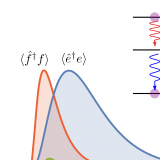
In the '70s, atomic cascades were used as the first sources of polarization-entangled photon pairs, making it possible to test nonlocal aspects of quantum mechanics for the first time. In our experiment, we have provided a new perspective on cascade decay by engineering a setting that is hardly reachable in the realm of atomic physics, namely, one in which a single emitter is coherently excited and decays into individual, well-defined, continuously monitored field modes. Our emitter is an artificial atom with transition frequencies in the microwave domain, stongly coupled to a one-dimensional waveguide. The emitter is prepared in a coherent superposition of the ground and second-excited state; when it decays, the coherence of its state is mapped onto two itinerant photonic modes, which we characterize using nearly-quantum-limited linear amplifiers. The ability to generate entanglement between spatially separated, itinerant radiation fields, as demonstrated in our experiment, is essential to quantum information distribution protocols.


